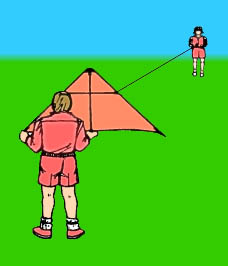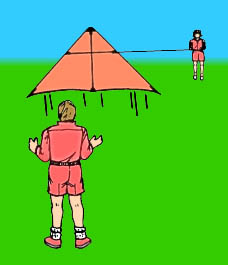Dragon kite
Stunt kite
Nylon Animal kite
Diamond kite
Delta kite
Box kite
pocket kite
tool
How to launch your single line kite
Figure 1 |
Make sure wind conditions are proper for
your kite. In fairly strong winds, you will be able to launch the kite
from your hand. Hold the kite up until it catches the wind, then slowly
let out the line through your gloved hand, giving gentle tugs as the kite
gains altitude. |
|
If the wind is lighter, take the kite about
50 feet downwind and stand it on end, or have a friend take it out and
hold it for you(see illustration). As the kite catches the wind pull in
line hand over hand with long steady pulls. When the kite becomes airborne
relax the tension on your line. The kite will glide downwind. Allow the
kite all the line it needs to glide unimpeded. As the kite nears the
ground, again give a series of long steady pulls on the line to regain
altitude. |
Figure 2
 |
|
QUESTIONS & ANSWERS:
Kite leans to one
side:
Correct balance by adding
weight to one side, or check the position of the side sticks making sure
they are even and to the back of the kite.
Kite makes quick
loops:
Wind too strong for the kite.
Deepen bow or lengthen tail.
Kite lacks lift, or is
sluggish:
Could be too much drag or
the kite is too heavy for the wind conditions. Reduce tail, lessen bow or
try on a windier day.
Kite appears top
heavy:
Bridle may be too low. Bow
too deep. Increase length and weight of tail.
Kite is
skittish:
Increase length of bridle.
Wind may be too strong, add or lengthen tail.
Kite
nose-dives:
Raise bridle position or
add a tail. Release tension if kite dives. the kite will swing out of the
dive, regain control by taking up slack.
Kite flies too
flat:
Lower bridle position. |
THE FOUR NEVERS OF KITE FLYING:
1. Never fly a kite in wet or
stormy weather and keep your line dry.
2. Never fly a kite near
electrical power lines, transmission towers or antennas. (If you lose a
kite on a line, call the utility company.)
3. Never fly a kite with
wire or anything metallic in its line.
4. Never fly a hard-pulling kite
without wearing gloves.
FIVE THINGS TO AVOID WHILE KITE FLYING:
1. Public streets and
highways-don't fly a kite in or over them.
2. Air traffic
patterns.
3. Bystanders in your kite's line of attack- especially when
flying maneuverable kites.
4. Rocky, bumpy or obstacle-filled fields-
they can trip you up.
5. Trees-but if you do lose a kite to a
kite-eating tree, loosen the line and let the wind fly it out.
SIR FRANCIS BEAUFORT WIND SCALE:
1-3 mph . . . . . . . . . .
smoke drifts lazily
4-7 mph . . . . . . . . . . tree leaves
dance
8-12 mph . . . . . . . . . small flags fly, leaves dance
13-18
mph . . . . . trees toss, dust flies, paper skitters
19-24 mph . . . .
. . . . trees sway, kite string breaks
25- 31 mph . . . . . . . .
flying risky |
Workmanship of Chinese kites
Workmanship
of Chinese kites can be summarized as four points: structuring,
paperhanging, colour-drawing, flying.
Structuring includes:
selecting material, cleaving bamboo, curving bamboo, joining
bamboo.
Paperhanging includes: selecting material, cutting out,
paperhanging, disposing and rectifying fringe.
Colour-drawing
includes: composing picture, outlining, dyeing,
decorating.
Flying includes: selecting site and weather, tool,
flying off, adjustment, controlling.
Adjustments
for common malfunctions of kites
1.
overturn and fall 2.side-fly 3.swaying 4.frontward 5. backward
6.circumgyration
Overturn and fall A sudden inversion with the head down and the tail up,
then fall sharply down on the ground .This is a phenomena called
overturn and fall.
Adjustments: Increase the weight of kiteís
tail so as to move the center of gravity downward.
Or you can
bend the tail backward, or move the angle line upward. Adjustments
need to be done according to the changes of the states of flying,
from which we judge how much is needed to done concerning effect and
degree. No matter which way mentioned above you use, it should be
done by keeping trying out and adjusting at the same time. If none
of them can work, the accuracy of the judgment of the malfunction is
the point should be thinking out. If judgment is right, then think
about the design of the kite.
Side-flyIt
refers to the phenomena that the appearance of a flying kite is not
upstanding, flying sideways all along. 3 adjustments are available
here:
(1). Holding the central axes of kite, examine whether the
weight of both sides are balanced.
If one side is heavier over
which the kite heel, we can conclude that the unbalanced weight
probably causes the side-fly.
Increasing the weight of this
side can solve the problem. Itís necessary to note that kites have
certain transverse stability that a small degree of unbalanced
weight wonít influence the kite . Reasons such as the dissymmetrical
transfiguration for kites and so on that causes the unbalance will
produce more influence on flying. Another possible situation is: The
heavier side is just on which the one goes upward during the flying.
We can see that, from this point, what causes heeling over.
(2).
Check if both sides have symmetrical structures. The asymmetry of
area, angle, hardness and softness of framework can cause the
unbalance of wind power that results in side-flying.
(3).
Adjusting the angle lines stud that makes it move to the direction
over which the kite heel. Please keep adjusting and experimental
flying in turn. Such a malfunction has nothing to do with the
designing of the kite.
About swaying Swaying and leaning are different. Leaning results in
heeling over one side all the time while swaying demonstrates going
form one side to another and heeling over to both sides from time to
time and falling down finally. The phenomenon of being fluctuant
forward and backward is possible as well.
Moving the
angle lines stud downward can solve this problem. Be sure keep the
movement and the experiment in turn, or problems may occur because
of overdoing. Decreasing the weight of the kiteís tail is also
helpful. Kites that have many angle lines can broaden the distances
of them.
Kites with one angle line is easy to be fluctuant
forward and backward, which can be solved by fixing up the tail and
the body and changing one angle ling to two.
Kites like
swallow is functioned to be fluctuant forward and backward during
the flying so as to produce the effect of vividness.
About frontward Kites tend to fall frontward as long as pulling the
line, which prove the line canít hold power. In this case, if the
kite has one angle line, it should be moved backward a bit. If the
kite has two or three angle lines, they should be shortened in
length and moved downward so as to strengthen the head to be
rise-oriented.
Thereíre several kinds of frontward. One is: so
long as pulling the line straightly and tightly, the kite will go
frontward, and then the line loosens up, the kite falls with the
head rise-oriented; another is: once the kite go frontward, it can
never lift the head up again. The reason for the former case is that
the angle line is over-upward, which can be solved by moving
downward. For the second case, besides the problems on designing,
the main reason is that the center of gravity is over-forward.
Increasing the weight of the tail and moving the angle line downward
can solve this problem.
Kite like soft-winged eagle usually flies
well in the lower sky while the phenomena of frontward occurs in the
upper sky. Then, the line loosens up and, instead of falling down
directly, the kite glides in the air. Under this circumstance, what
the player needs to do is just speeding up drawing the line back;
any kind of the adjusting is unnecessary.
About backward
Being hard to ascend is the phenomena referring to
backward. When there is enough wind, the line is tightened while the
kite is only in a way of keeping going further off instead of
ascending higher. The degree of the angle between the line and
ground is small; when there isnít much wind, the kite will fall
backward, which can be adjusted by moving the angle line upward. If
the angle lines are many, then the upper angle line needs to be
tightened and the lower one, lengthened. Too much weight on the kite
also can cause such a problem. Under such circumstance, decreasing
the weight of the tail can be helpful.
About turning
Turning refers to the kite twirls to right and left
sides. Reasons causing such a phenomena could be various, which
means, therefore, the adjusting varies to experiment. For example,
kite with one angle line will twirl due to the unbalance of holding
power caused by the improper placement of the angle line, which is
same to kite with several ones. Furthermore, asymmetry because of
transfiguration resulting in heavy wind and over-small side face
area of the kite and so on are also the general reasons causing the
turning .
| FeiLong Kite M.P. : 18363688061 Email: wfkite@163.com |

